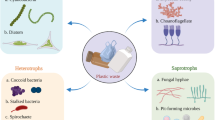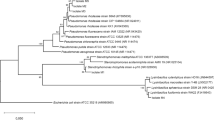Abstract
Humans have developed many materials with benefits which are unnatural. One such was the introduction of plastics in the early 20th century, which reaches its peak within the next 100 yr. Plastics are highly versatile and inexpensive materials, which are ubiquitous in modern life. Recycling plastics or reducing their use does not resolve the growing problem. Globally, the accumulation of plastics in water bodies has become a serious problem. Therefore, there is a need to degrade them in an environmentally-friendly manner. Despite having plenty of information on the degradation of plastics, only a few studies have reported the bioremediation of plastics. The present study aimed at microbial degradation of the five plastic films including polyamide (PA), polyethylene (PE), polyvinyl chloride (PVC), polystyrene (PS), and polypropylene (PP) using biofilm formation. The plastic films were exposed to waste water for 30 days. Microbial biofilms developed rapidly on the plastic samples within 3–4 weeks. PA and PVC films were covered with biofilms indicating the colonization process. Biodegradation was estimated in terms of weight loss and reduction rate. It was observed that PA mass decreased by 28.42%, followed by PVC (25.6%). The uptake rate of the PA by the biofilm was 0.0111 day–1 and the shortest half-life was observed for PA (62.44 days). The surface changes were visualized by scanning electron microscopy (SEM). SEM images revealed the attachment of the rod-shaped bacteria and the accumulation of different types of salts. Thus, the experiments provide an inventive bioremediation of plastics like PA followed by PVC using the environment–friendly biofilms.





Similar content being viewed by others
REFERENCES
Alaribe, F.O. and Agamuthu, P., Assessment of phytoremediation potentials of Lantana camara in Pb impacted soil with organic waste additives, Ecol. Eng., 2015, vol. 83, pp. 513–520.
Auta, H.S., Emenike, C.U., and Fauziah, S.H., Screening of Bacillus strains isolated from mangrove ecosystems in Peninsular Malaysia for microplastic degradation, Environ. Pollut., 2017, vol. 231, pp. 1552–1559.
Barnes, D.K.A., Galgani, F., Thompson, R.C., and Barlaz, M., Accumulation and fragmentation of plastic debris in global environments, Philos. Trans. R. Soc. Lond. B Biol. Sci., 2009, vol. 364, pp. 1985–1998.
Bhagwat, G., O’Connor, W., Grainge, I., and Palanisami, T., Understanding the fundamental basis for biofilm formation on plastic surfaces: role of conditioning films, Front Microbiol., 2021, vol. 12, p. 687118.
Bondar-Kunze, E., Maier, S., Schonauer, D., Bahl, N., and Hein, T., Antagonistic and synergistic effects on a stream periphyton community under the influence of pulsed flow velocity increase and nutrient enrichment, Sci. Total Environ., 2016, vol. 573, pp. 594–602. https://doi.org/10.1016/j.scitotenv.2016.08.158
Caballero, B., Finglas, P., and Toldrá, F., Encyclopedia of Food and Health, Academic, 2015.
Chen, C.J., Han, Z.Y., Zhu, Y.M., and Wu, W.X., Periphyton and its application in water purification, Yingyong Shengtai Xuebao, 2009, vol. 20, no. 11, pp. 2820–2826.
Coelho, L.M., Rezende, H.C., Coelho, L.M., de Sousa, P., Melo, D., and Coelho, N., Bioremediation of polluted waters using microorganisms, Adv. Bioremediat. Wastewater Poll. Soil, 2015, vol. 10, p. 60770.
Collignon, A., Hecq, J.H., Glagani, F., Voisin, P., Collard, F., and Goffart, A., Neustonic microplastic and zooplankton in the North Western Mediterranean Sea, Mar. Pollut. Bull., 2012, vol. 64, no. 4, pp. 861–864.
Costerton, J.W., Lewandowski, Z., Caldwell, D.E., Korber, D.R., and Lappin-Scott, H.M., Microbial biofilms, Annu. Rev. Microbiol., 1995, vol. 49, pp. 711–745.
Dobretsov, S., Marine biofilms, in Biofouling, Dürr, S. and Thomason, J.C., Eds., Chichester: Wiley, 2010, pp. 123–136.
Donlan, R.M., Biofilms: microbial life on surfaces, Emerg. Infect. Dis., 2002, vol. 8, no. 9, p. 881.
Dris, R., Gasperi, J., Saad, M., Mirande, C., and Tassin, B., Synthetic fibers in atmospheric fallout: a source of microplastics in the environment?, Mar. Pollut. Bull., 2016, vol. 104, pp. 290–293.
Erni-Cassola, G., Wright, R.J., Gibson, M.I., and Christie-Oleza, J.A., Early colonization of weathered polyethylene by distinct bacteria in marine coastal seawater, Microb. Ecol., 2020, vol. 79, pp. 517–526. https://doi.org/10.1007/s00248-019-01424-5
Gasperi, J., Wright, S.L., Dris, R., Collard, F., Mandin, C., Guerrouache, M., Langlois, V., Kelly, F.J., and Tassin, B., Microplastics in air: are we breathing it in?, Curr. Opin. Environ. Sci. Health, 2018, vol. 1, pp. 1–5.
GESAMP, Sources Fate and Effects of Microplastics in the Marine Environment: A Global Assessment, 2015.
Geyer, R., Jambeck, J.R., and Law, K.L., Production, use, and fate of all plastics ever made, Sci. Adv., 2017, vol. 3, art. e1700782.
Gies, E.A., LeNoble, J.L., Noël, M., Etemadifar, A., Bishay, F., Hall, E.R., and Ross, P.S., Retention of microplastics in a major secondary wastewater treatment plant in Vancouver, Canada, Mar. Pollut. Bull., 2018, vol. 133, pp. 553–561.
Gilbert, M., Plastics Materials: Introduction and Historical Development, Brydson’s Plastics Materials, 2016, 8th ed., pp. 2–18. https://doi.org/10.1016/B978-0-323-35824-8.00001-3
Harshvardhan, K. and Jha, B., Biodegradation of low-density polyethylene by marine bacteria from pelagic waters, Arabian Sea, India, Mar. Pollut. Bull., 2013, vol. 77, nos. 1–2, pp. 100–106.
Kulkarni, A. and Dasari, H., Current status of methods used in degradation of polymers: a review, in MATEC Web of Conferences, 2018, vol. 144, p. 02023 EDP Sciences.
Mor, R. and Sivan, A., Biofilm formation and partial biodegradation of polystyrene by the actinomycete Rhodococcus ruber, Biodegradation, 2008, vol. 19, no. 6, pp. 851–858.
Morohoshi, T., Ogata, K. Okura, T., and Sato, S., Molecular characterization of the bacterial community in biofilms for degradation of poly(3-hydroxybutyrate-co-3-hydroxyhexanoate) films in seawater, Microbes Environ., 2018, vol. 33, pp. 19–25.
Morohoshi, T., Oi, T., Aiso, H., Suzuki, T., Okura, T., and Sato, S., Biofilm formation and degradation of commercially available biodegradable plastic films by bacterial consortiums in freshwater environments, Microbes Environ., 2018, vol. 33, pp. 332–335. https://doi.org/10.1264/jsme2.ME18033
Muniasamy, K.G., Pérez-Guevara, F., Martinez, I.E., and Shruti, V.C., Overview of microplastics pollution with heavy metals: analytical methods, occurrence, transfer risks and call for standardization, J. Hazad. Mater., 2021, 26, art. 125755.
Ngo, P.L., Pramanik, B.K., Shah, K., and Roychand, R., Pathway, classification and removal efficiency of microplastics in wastewater treatment plants, Environ. Pollut., 2019, vol. 255, pp. 113–326.
Olsen, T.A., Brandt, C.C., and Brooks, S.C., Periphyton biofilms influence net methylmercury production in an industrially contaminated system, Environ. Sci. Technol., 2016, vol. 50, no. 20, pp. 10 843–10 850.
Rivadeneyra, A., Gonzalez-Martinez, A., Gonzalez-Lopez, J., Martin-Ramos, D., Martinez-Toledo, M.V., and Rivadeneyra, M.A., Precipitation of phosphate minerals by microorganisms isolated from a fixed-biofilm reactor used for the treatment of domestic wastewater, Int. J. Environ. Res. Public Health, 2014, vol. 11, pp. 3689–3704. https://doi.org/10.3390/ijerph110403689
Shabbir, S., Faheem, M., Ali, N., Kerr, P.G., and Wu, Y., Periphyton biofilms: a novel and natural biological system for the effective removal of sulphonated azo dye methyl orange by synergistic mechanism, Chemosphere, 2017, vol. 167, pp. 236–246. https://doi.org/10.1016/j.chemosphere.2016.10.002
Shabbir, S., Faheem, M., Ali, N., Kerr, P.G., Wang, L.F., Kuppusamy, S., and Li, Y., Periphytic biofilm: an innovative approach for biodegradation of microplastics, Sci. Total Environ., 2020, vol. 717, p. 137064.
Thompson, R.C., Olsen, Y., Mitchell, R.P., Davis, A., Rowland, S.J., John, A.W., McGonigle, D., and Russell, A.E., Lost at sea: where is all the plastic?, Science, 2004, vol. 304, p. 838.
Zhao, J., Li, Y., Chen, X., and Li, Y., Effects of carbon sources on sludge performance and microbial community for 4-chlorophenol wastewater treatment in sequencing batch reactors, Bioresour. Technol., 2018, vol. 255, pp. 22–28.
Zhurina, M.V., Kallistova, A.Y., Panyushkina, A.E., Gannesen, A.V., Mart’yanov, S.V., Gerasin, V.A., and Plakunov, V.K., Specific features of formation of multispecies microbial biofilms on polyethylene surface, Microbiology (Moscow), 2020, vol. 89, pp. 396–404.
ACKNOWLEDGMENTS
We express our sincere gratitude to the Departments of Plant Science, and Chemistry, Madurai Kamaraj University, Madurai. We also extend our thanks to all the faculties and research scholars of the Department of Plant Science for their kind corporation and guidance in the successful completion of the project.
Funding
This work was completed under the UGC-STRIDE IRCECCB Visiting Fellowship—2022 program at Madurai Kamaraj University, Madurai, Tamil Nadu, India.
Author information
Authors and Affiliations
Corresponding author
Ethics declarations
The authors declare that they have no conflicts of interest. This article does not contain any studies involving animals or human participants performed by any of the authors.
Rights and permissions
About this article
Cite this article
Amritha, P.S., Veena, V. & Harathi, P.B. Model Periphyton Biofilms: Biological System of Bioremediation of Synthetic Plastics. Microbiology 92, 686–694 (2023). https://doi.org/10.1134/S002626172260358X
Received:
Revised:
Accepted:
Published:
Issue Date:
DOI: https://doi.org/10.1134/S002626172260358X




